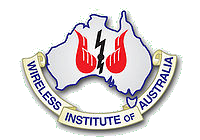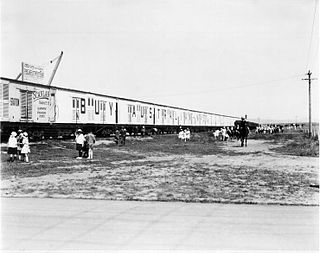The AWA 3B Wireless Set was a wireless radio transceiver used by the Australian Army and Coastwatchers during World War II. The unit was made by Australian company AWA.

The Wireless Set Number 11, or WS No. 11, was a radio set designed for the British Army in 1938. It was designed to replace the 1933 Wireless Set No. 1 which had been found inadequate for a number of reasons. Like the No. 1, it was designed to be used in fixed locations like regimental field headquarters, as well as in vehicles and tanks.

It is generally recognized that the first radio transmission was made from a temporary station set up by Guglielmo Marconi in 1895 on the Isle of Wight. This followed on from pioneering work in the field by a number of people including Alessandro Volta, André-Marie Ampère, Georg Ohm, James Clerk Maxwell and Heinrich Rudolf Hertz.

The Wireless Institute of Australia (WIA) was formed in 1910, and is the first and oldest national amateur radio society in the world. It represents the amateur radio operators of Australia as the AR "peak body" in dealings with the Australian Communications and Media Authority (ACMA), the authority under the government of Australia that administers communications within and external to Australia. The WIA publishes a bi-monthly journal for its membership called Amateur Radio. The organisation is the national society representing Australia in the International Amateur Radio Union. The WIA holds regular meetings with the ACMA to inform the Authority on matters concerning the Australian amateur radio community.

ABC Radio Perth is the on-air identifier of a radio station located in Perth, Western Australia, operated by the Australian Broadcasting Corporation, and broadcasting at 720 kHz AM. It is the flagship ABC Local Radio station in Western Australia. The station was established under the Sealed Set scheme by Westralian Farmers in 1924, sold to the Commonwealth Government in 1928 and provided with programmes by the Australian Broadcasting Company, became part of the Australian Broadcasting Commission in 1932, which became the Australian Broadcasting Corporation in 1983.

AWA Technology Services, formerly named Amalgamated Wireless (Australasia) Ltd, is an Australian communications technology company. Throughout most of the twentieth century, AWA was Australia's largest and most prominent electronics organisation, undertaking development, manufacture and distribution of radio, telecommunications, television and audio equipment as well as broadcasting services.

The AWA Tower is a heritage-listed office and communications complex in Sydney, in the state of New South Wales, Australia built for AWA. The AWA Tower consists of a radio transmission tower atop a 15-storey building. It is located in the Sydney central business district at 45-47 York Street, close to Wynyard Park and Wynyard railway station. It was designed by Robertson, Marks and McCredie in association with DT Morrow and Gordon and built from 1937 to 1939 by William Hughes and Co. Pty Ltd. It was added to the New South Wales State Heritage Register on 2 April 1999.
The Overseas Telecommunications Veterans Association was founded in Sydney, Australia in 1956 by long-serving employees and ex-employees of Amalgamated Wireless Australasia (AWA), Cable & Wireless and Australia's then international telecommunications carrier, the Overseas Telecommunications Commission (OTC), which had itself been established a decade earlier by combining the international radio and cable assets of AWA and C&W respectively.

The Great White Train was an effort in the 1920s by Sydney based industrialists to convince Australians to Buy Australian Made.
The Antique Wireless Association (AWA) is chartered as a non-profit educational organization in New York State and is an IRS 501(c)(3) tax-exempt corporation based in Bloomfield, New York. It was originally established in 1952 by Bruce Kelley, George Batterson, and Linc Cundall for operators and collectors of radio equipment. The association currently has more than 1300 international members. It is a member of the American Association of Museums. It hosts an annual meeting in August. The association runs the Antique Wireless Museum.

The No. 208 Wireless Set was a wireless radio transceiver used by the Australian Army during the Second World War. Developed in 1941, the unit was based on the Army No. 108 Wireless Set and manufactured by AWA. There were three versions, the 208, 208* and the 208 Mark II. The 208 could be carried, but not operated, in a backpack.
Fritz Langford-Smith was an Australian electrical engineer. He was the author of the classic engineering reference Radiotron Designer's Handbook (RDH). He was heavily involved in the science of communication and engineering research in England and in Australia. He was a long-term editor of the journal Radiotronics (1935–1950).

Sir Ernest Thomas Fisk was an English Australian businessman and entrepreneur, TV and radio engineer, he was the founder (1913) and later managing director (1916) and chairman (1932) of Amalgamated Wireless (Australasia) (AWA). In 1944 was appointed managing director of the EMI music empire.
2CM was an experimental Australian broadcasting station operated by Charles Dansie Maclurcan. In 1921, 2CM became the first Australian station to regularly broadcast music and talk..
The history of broadcasting in Australia has been shaped for over a century by the problem of communication across long distances, coupled with a strong base in a wealthy society with a deep taste for aural communications in a silent landscape. Australia developed its own system, through its own engineers, manufacturers, retailers, newspapers, entertainment services, and news agencies. The government set up the first radio system, and business interests marginalized the hobbyists and amateurs. The Labor Party was especially interested in radio because it allowed them to bypass the newspapers, which were mostly controlled by the opposition. Both parties agreed on the need for a national system, and in 1932 set up the Australian Broadcasting Commission, as a government agency that was largely separate from political interference.
John Ernest Benson (1911–1989) was an Australian engineer and researcher who contributed to studies on piezoelectric crystals, television and sound systems, particularly loudspeakers.

Wireless Weekly was Australia's first news-stand wireless magazine, published in 1922 in Sydney by William John Foster St Clair Maclardy and his father William McIntyre St Clair Maclardy. W. J. Maclardy was one of the founders of the "A" Class radio station 2SB. It arose from conversations between Florence Violet (Vera) McKenzie OBE, aka 'Violet Wallace, 'Vera Wallace' and later 'Mrs Mac' (1890-1982), who owned a wireless shop in the Royal Arcade, Sydney, Ron Marsden her engineer, and Maclardy. The front cover featured a photo of amateur radio activity.
Arthur William Jarrett was a pioneer radio broadcaster in South Australia.
Australasian Wireless relates to two separate entities: Australasian Wireless Limited and Australasian Wireless Company Limited. The former obtained an option to acquire the exclusive rights to the Telefunken wireless telegraphy system in Australasia, the latter acquired those rights and with public capital developed a firm which was successful in supplying wireless telegraphy equipment to shipping in Australasian waters and the establishment of Australia's first coastal radio stations. When the Australian Government decided to complete the remainder of the coastal network using the Balsillie wireless system manufactured by Father Archibald Shaw, AWCL merged with Marconi interests to form Amalgamated Wireless (Australasia). This merged firm eventually won the exclusive right to operate Australia's coastal radio network and went on to become the dominant company in Australia's radiocommunications and broadcasting industry.
The California Historical Radio Society (CHRS) is a non-profit organization centered on the history of radio and radio broadcasting, including related technologies such as vintage TV, amateur radio and HiFi. The focus is on the history of early radio and early radio broadcasting in California, especially the San Francisco Bay Area and the western states. Its museum and headquarters, known as "Radio Central," are located in Alameda, California.